Kiran B. Raja
Log-Likelihood Score Level Fusion for Improved Cross-Sensor Smartphone Periocular Recognition
Nov 02, 2023Abstract:The proliferation of cameras and personal devices results in a wide variability of imaging conditions, producing large intra-class variations and a significant performance drop when images from heterogeneous environments are compared. However, many applications require to deal with data from different sources regularly, thus needing to overcome these interoperability problems. Here, we employ fusion of several comparators to improve periocular performance when images from different smartphones are compared. We use a probabilistic fusion framework based on linear logistic regression, in which fused scores tend to be log-likelihood ratios, obtaining a reduction in cross-sensor EER of up to 40% due to the fusion. Our framework also provides an elegant and simple solution to handle signals from different devices, since same-sensor and cross-sensor score distributions are aligned and mapped to a common probabilistic domain. This allows the use of Bayes thresholds for optimal decision-making, eliminating the need of sensor-specific thresholds, which is essential in operational conditions because the threshold setting critically determines the accuracy of the authentication process in many applications.
Morton Filters for Superior Template Protection for Iris Recognition
Jan 15, 2020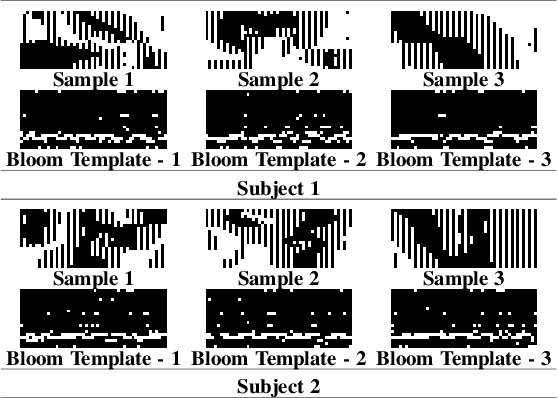
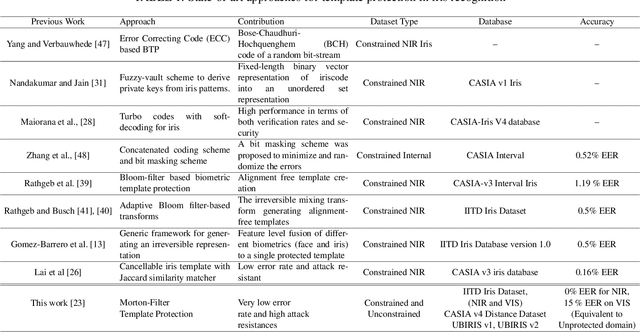
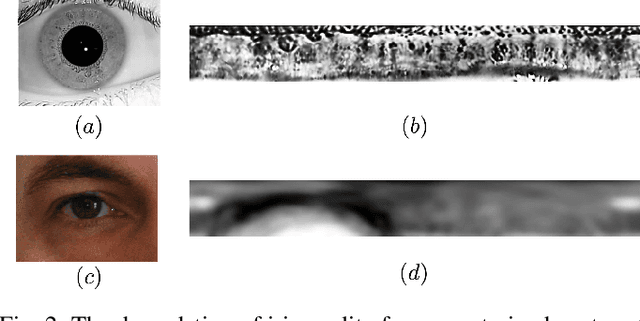

Abstract:We address the fundamental performance issues of template protection (TP) for iris verification. We base our work on the popular Bloom-Filter templates protection & address the key challenges like sub-optimal performance and low unlinkability. Specifically, we focus on cases where Bloom-filter templates results in non-ideal performance due to presence of large degradations within iris images. Iris recognition is challenged with number of occluding factors such as presence of eye-lashes within captured image, occlusion due to eyelids, low quality iris images due to motion blur. All of such degrading factors result in obtaining non-reliable iris codes & thereby provide non-ideal biometric performance. These factors directly impact the protected templates derived from iris images when classical Bloom-filters are employed. To this end, we propose and extend our earlier ideas of Morton-filters for obtaining better and reliable templates for iris. Morton filter based TP for iris codes is based on leveraging the intra and inter-class distribution by exploiting low-rank iris codes to derive the stable bits across iris images for a particular subject and also analyzing the discriminable bits across various subjects. Such low-rank non-noisy iris codes enables realizing the template protection in a superior way which not only can be used in constrained setting, but also in relaxed iris imaging. We further extend the work to analyze the applicability to VIS iris images by employing a large scale public iris image database - UBIRIS(v1 & v2), captured in a unconstrained setting. Through a set of experiments, we demonstrate the applicability of proposed approach and vet the strengths and weakness. Yet another contribution of this work stems in assessing the security of the proposed approach where factors of Unlinkability is studied to indicate the antagonistic nature to relaxed iris imaging scenarios.
Detecting Finger-Vein Presentation Attacks Using 3D Shape & Diffuse Reflectance Decomposition
Dec 03, 2019
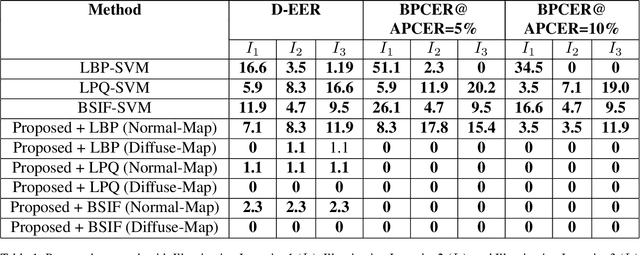
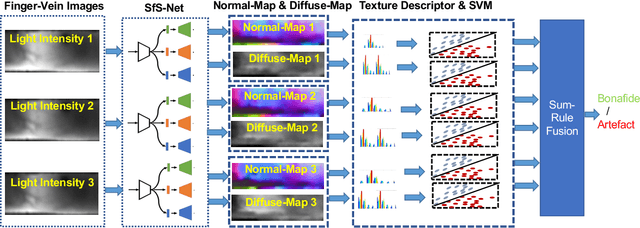

Abstract:Despite the high biometric performance, finger-vein recognition systems are vulnerable to presentation attacks (aka., spoofing attacks). In this paper, we present a new and robust approach for detecting presentation attacks on finger-vein biometric systems exploiting the 3D Shape (normal-map) and material properties (diffuse-map) of the finger. Observing the normal-map and diffuse-map exhibiting enhanced textural differences in comparison with the original finger-vein image, especially in the presence of varying illumination intensity, we propose to employ textural feature-descriptors on both of them independently. The features are subsequently used to compute a separating hyper-plane using Support Vector Machine (SVM) classifiers for the features computed from normal-maps and diffuse-maps independently. Given the scores from each classifier for normal-map and diffuse-map, we propose sum-rule based score level fusion to make detection of such presentation attack more robust. To this end, we construct a new database of finger-vein images acquired using a custom capture device with three inbuilt illuminations and validate the applicability of the proposed approach. The newly collected database consists of 936 images, which corresponds to 468 bona fide images and 468 artefact images. We establish the superiority of the proposed approach by benchmarking it with classical textural feature-descriptor applied directly on finger-vein images. The proposed approach outperforms the classical approaches by providing the Attack Presentation Classification Error Rate (APCER) & Bona fide Presentation Classification Error Rate (BPCER) of 0% compared to comparable traditional methods.
Robust Morph-Detection at Automated Border Control Gate using Deep Decomposed 3D Shape and Diffuse Reflectance
Dec 03, 2019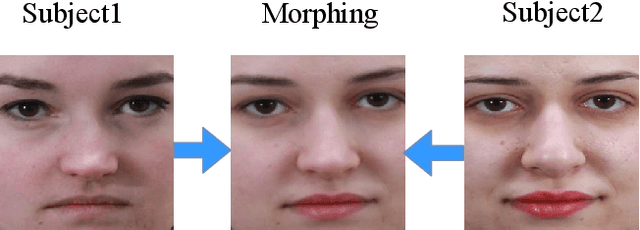


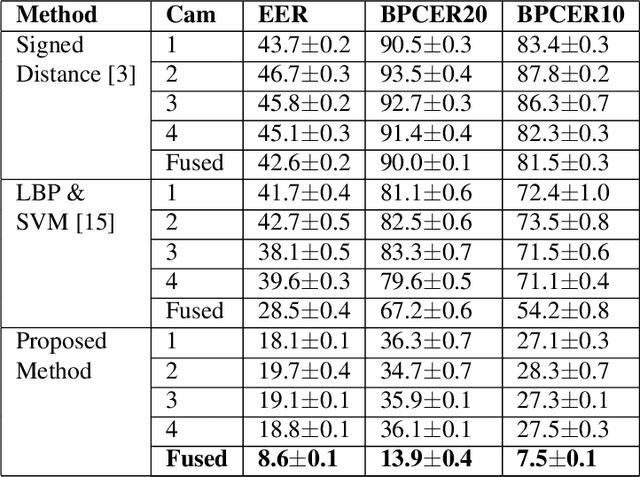
Abstract:Face recognition is widely employed in Automated Border Control (ABC) gates, which verify the face image on passport or electronic Machine Readable Travel Document (eMTRD) against the captured image to confirm the identity of the passport holder. In this paper, we present a robust morph detection algorithm that is based on differential morph detection. The proposed method decomposes the bona fide image captured from the ABC gate and the digital face image extracted from the eMRTD into the diffuse reconstructed image and a quantized normal map. The extracted features are further used to learn a linear classifier (SVM) to detect a morphing attack based on the assessment of differences between the bona fide image from the ABC gate and the digital face image extracted from the passport. Owing to the availability of multiple cameras within an ABC gate, we extend the proposed method to fuse the classification scores to generate the final decision on morph-attack-detection. To validate our proposed algorithm, we create a morph attack database with overall 588 images, where bona fide are captured in an indoor lighting environment with a Canon DSLR Camera with one sample per subject and correspondingly images from ABC gates. We benchmark our proposed method with the existing state-of-the-art and can state that the new approach significantly outperforms previous approaches in the ABC gate scenario.
Cross-Sensor Periocular Biometrics: A Comparative Benchmark including Smartphone Authentication
Feb 21, 2019



Abstract:The massive availability of cameras and personal devices results in a wide variability between imaging conditions, producing large intra-class variations and performance drop if such images are compared for person recognition. However, as biometric solutions are extensively deployed, it will be common to replace acquisition hardware as it is damaged or newer designs appear, or to exchange information between agencies or applications in heterogeneous environments. Furthermore, variations in imaging bands can also occur. For example, faces are typically acquired in the visible (VW) spectrum, while iris images are captured in the near-infrared (NIR) spectrum. However, cross-spectrum comparison may be needed if for example a face from a surveillance camera needs to be compared against a legacy iris database. Here, we propose a multialgorithmic approach to cope with cross-sensor periocular recognition. We integrate different systems using a fusion scheme based on linear logistic regression, in which fused scores tend to be log-likelihood ratios. This allows easy combination by just summing scores of available systems. We evaluate our approach in the context of the 1st Cross-Spectral Iris/Periocular Competition, whose aim was to compare person recognition approaches when periocular data from VW and NIR images is matched. The proposed fusion approach achieves reductions in error rates of up to 20-30% in cross-spectral NIR-VW comparison, leading to an EER of 0.22% and a FRR of just 0.62% for FAR=0.01%, representing the best overall approach of the mentioned competition.. Experiments are also reported with a database of VW images from two different smartphones, achieving even higher relative improvements in performance. We also discuss our approach from the point of view of template size and computation times, with the most computationally heavy system playing an important role in the results.
 Add to Chrome
Add to Chrome Add to Firefox
Add to Firefox Add to Edge
Add to Edge